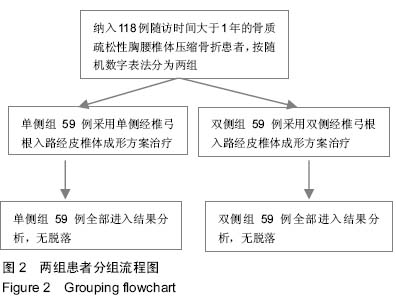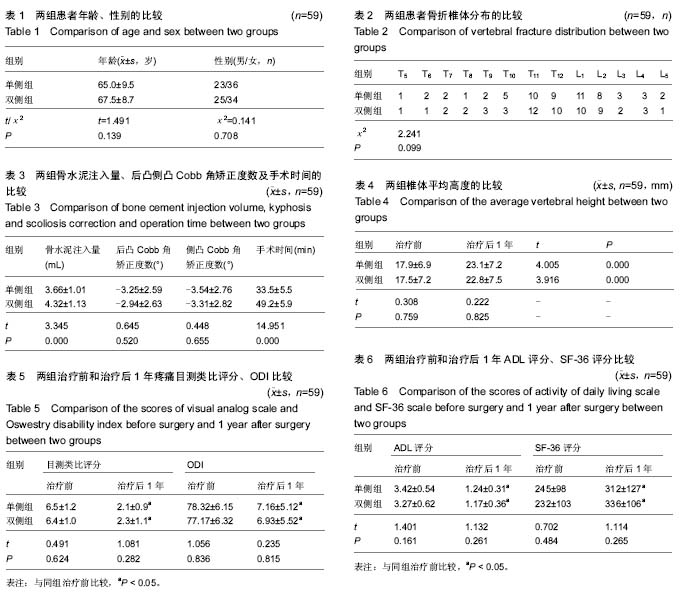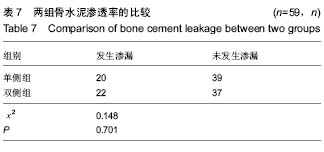中国组织工程研究 ›› 2015, Vol. 19 ›› Issue (30): 4892-4897.doi: 10.3969/j.issn.2095-4344.2015.30.026
• 生物材料临床实践 clinical practice of biomaterials • 上一篇 下一篇
经皮椎体成形骨水泥注入修复骨质疏松性胸腰椎体压缩骨折:椎弓根入路方案
蔡 佳1,郝应文1,李 超2,杨化群1
- 1新疆喀什地区第一人民医院骨科,新疆维吾尔自治区喀什市 844000;
2新疆伽师县人民医院骨科,新疆维吾尔自治区喀什市 844300
Percutaneous verterbroplasty with bone cement injection for osteoporotic vertebral compression fractures via transpedicular approach
Cai Jia1, Hao Ying-wei1, Li Chao2, Yang Hua-qun1
- 1Department of Orthopedics, the First People’s Hospital of Kashi, Kashi 844000, Xinjiang Uygur Autonomous Region, China;
2Department of Orthopedics, Jiashi People’s Hospital, Kashi 844000, Xinjiang Uygur Autonomous Region, China
摘要:
背景:研究证明经皮椎体成形是修复骨质疏松性椎体压缩骨折一种比较好的方法,但是具体的椎弓根入路方案研究尚少,采用单侧还是双侧经椎弓根入路经皮椎体成形来修复骨质疏松性椎体压缩骨折目前尚有争议。
目的:比较单侧及双侧经椎弓根入路经皮椎体成形对骨质疏松性胸腰椎体压缩骨折的修复效果。
方法:选择新疆喀什地区第一人民医院骨科2010年6月到2013年6月收治的118例随访时间大于1年的骨质疏松性胸腰椎体压缩骨折患者,根据随机数字表法分为两组,分别采取单侧和双侧经椎弓根入路经皮椎体成形方案治疗,每组59例。比较两组患者骨水泥注入量、骨水泥渗漏率、后凸侧凸Cobb角矫正度数、椎体平均高度变化、目测类比评分、Oswestry功能障碍指数、日常生活能力评分、健康调查简表SF-36评分及治疗后并发症发生情况。
结果与结论:单侧组骨水泥渗漏率(34%)比双侧组(37%)低,但差异无显著性意义(P=0.701 > 0.05)。两组后凸Cobb角矫正度数、侧凸Cobb角矫正度数差异均无显著性意义(P > 0.05)。两组间治疗前或治疗后1年椎体平均高度变化差异无显著性意义(P > 0.05),两组治疗后1年椎体平均高度均较治疗前显著改善(P < 0.05)。两组间治疗前或治疗后目测类比评分、功能障碍指数问卷评分、日常生活能力评分、健康调查简表评分差异均无显著性意义(P > 0.05),两组治疗后1年目测类比疼痛评分、ODI、日常生活能力评分、SF-36评分均较治疗前显著改善(P < 0.05)。单侧组骨水泥注入量比双侧组低(P=0.001 < 0.05),单侧组手术时间比双侧组短(P=0.000 < 0.05)。两组均未发生严重术后并发症。提示对骨质疏松性胸腰椎体压缩骨折患者行单侧和双侧经椎弓根入路经皮椎体成形治疗均有满意的止痛和修复效果,尤其是单侧入路具有水泥注入量少、渗漏率低、手术时间短的优势。 中国组织工程研究杂志出版内容重点:生物材料;骨生物材料; 口腔生物材料; 纳米材料; 缓释材料; 材料相容性;组织工程
中图分类号:


